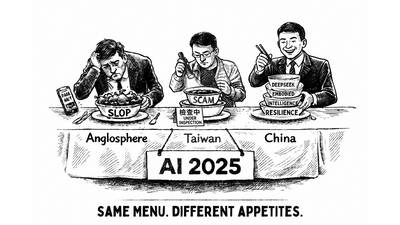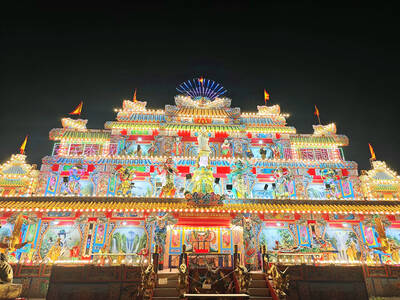Lai Chuan-chien’s (賴傳鑑) artistic career almost ended before it began. Born in Chungli in 1926, he gained early recognition for his brushwork, winning several competitions which in turn opened the door for him to move to Japan in the early 1940s to study art. But when the tide turned against Japan in World War II, he was forced to abandon his training there and return to Taiwan.
Lai’s abrupt departure from Japan is one of many anecdotes recounted by the Taipei Fine Arts Museum (TFAM) in its new exhibition, Lai Chuan-chien: 80th Anniversary Retrospective (賴傳鑑八十回顧展). The oddly titled show (isn’t it three years late?) traces the evolution of Lai’s tremendous career, beginning with his Japanese-inspired realist pieces. Though Lai’s Japanese roots are evident throughout the show, his later works also reveal the long-lasting influence of cubism and abstract art, styles that shaped many artists of Lai’s generation.
Lai’s early pieces echo the approach of other Japanese-trained artists working in Taiwan in the immediate aftermath of the war. Painting the people and places around him, Lai employs a realist style, emphasizing a stable, three-dimensional perspective and highlighting the play of light through his use of white.
Old Gate as Before (老門依然) depicts the interior of Lai’s father’s store, while Early Summer (初夏) is a portrait of his sister. Both use earthy-brown tones, the former suffused with yellows, the latter with shades of green. Like many of his paintings from the 1950s, they reflect Lai’s romantic perception of his hometown.
Though such pieces were recognized by numerous exhibitions, Lai nevertheless believed that his artistic training was incomplete. In addition to studying on his own, he soon found a mentor in Li Shih-chiao (李石樵). A respected artist, Li’s investigations into cubism helped shape Lai’s development.
Li’s influence is visible in Fishing (1) (漁 (1)). Wisps of sky blue and malachite streak across a colorful sea of geometrical and fragmented blocks, a medley of saturated reds and dull yellows and oranges. Lai’s fondness for visible brushstrokes infuses the work with a tactile quality, increasing the viewer’s sense of movement and perspective. While Peacock (孔雀), from this same period, uses a similar cleavage of color, Lai employs a cold palette of blues in place of the warm reds and yellows of Fishing (1).
Lai’s later canvases from the mid-1960s reveal an artist in the throes of experimentation with cubism, as well as abstract and more concrete styles. Though the former two tend to take precedence, an element of realism pervades Lai’s work in the latter part of the decade, meshing with the indeterminacy of abstract art and the blocks of perspective distinct to cubism.
Market (1) (市場 (1)) combines the distinct outlines of sitting figures, forms that fill a scene dominated by geometric shapes of bold color. This painting, as well as its complementary piece, Market (2) (市場 (2)), represents an early manifestation of the subject matter (female nude) and color (hints of purple, blue and yellow pastel within a framework of warm hues) that would come to characterize Lai’s later work.
As his style develops, Lai enhances the contours of the female figure by merging shades of brown with yellow, as evidenced by both Messenger of Spring (春之使者) and Summertime (夏日). This technique eventually results in the fully detailed figure visible in Summer Day Travel Sentiment (夏日旅情).
Though Lai’s post-1980s paintings are likewise filled with blocks of alternating perspective and pure color, such pieces also mark a return to his realist roots. This shift in style is reflective of the broadening influence of Lai’s extensive travels. The warm colors and totemic images visible in Abundant Harvest (豐收) and Horse Riding (三人行) evoke the primitivism of Paul Gauguin, an homage inspired by Lai’s experiences in Taiwan’s outlying islands. Early Morning of Budapest (布達佩斯之晨) and Overlooking Prague (布拉克展望) are suffused with a pastel play of light and rhythmic aura, both of which are reminiscent of Paul Cezanne.
Retrospectives offer a window into the development of an artist’s career. In exploring the evolution of Lai’s work, TFAM embarks on a complex journey through both the artist’s stylistic progression and the historical context within which he operated. Though Lai’s art is characterized by its amalgamation of contemporary and traditional techniques, his ability to combine these disparate styles into an original whole is unique, a talent that distinguishes him as one of Taiwan’s most important modernists.

Jan. 5 to Jan. 11 Of the more than 3,000km of sugar railway that once criss-crossed central and southern Taiwan, just 16.1km remain in operation today. By the time Dafydd Fell began photographing the network in earnest in 1994, it was already well past its heyday. The system had been significantly cut back, leaving behind abandoned stations, rusting rolling stock and crumbling facilities. This reduction continued during the five years of his documentation, adding urgency to his task. As passenger services had already ceased by then, Fell had to wait for the sugarcane harvest season each year, which typically ran from

It’s a good thing that 2025 is over. Yes, I fully expect we will look back on the year with nostalgia, once we have experienced this year and 2027. Traditionally at New Years much discourse is devoted to discussing what happened the previous year. Let’s have a look at what didn’t happen. Many bad things did not happen. The People’s Republic of China (PRC) did not attack Taiwan. We didn’t have a massive, destructive earthquake or drought. We didn’t have a major human pandemic. No widespread unemployment or other destructive social events. Nothing serious was done about Taiwan’s swelling birth rate catastrophe.

Words of the Year are not just interesting, they are telling. They are language and attitude barometers that measure what a country sees as important. The trending vocabulary around AI last year reveals a stark divergence in what each society notices and responds to the technological shift. For the Anglosphere it’s fatigue. For China it’s ambition. For Taiwan, it’s pragmatic vigilance. In Taiwan’s annual “representative character” vote, “recall” (罷) took the top spot with over 15,000 votes, followed closely by “scam” (詐). While “recall” speaks to the island’s partisan deadlock — a year defined by legislative recall campaigns and a public exhausted

In the 2010s, the Communist Party of China (CCP) began cracking down on Christian churches. Media reports said at the time that various versions of Protestant Christianity were likely the fastest growing religions in the People’s Republic of China (PRC). The crackdown was part of a campaign that in turn was part of a larger movement to bring religion under party control. For the Protestant churches, “the government’s aim has been to force all churches into the state-controlled organization,” according to a 2023 article in Christianity Today. That piece was centered on Wang Yi (王怡), the fiery, charismatic pastor of the